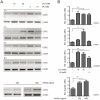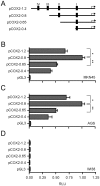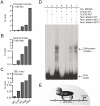Wnt/β-catenin signaling enhances cyclooxygenase-2 (COX2) transcriptional activity in gastric cancer cells
- PMID: 21494638
- PMCID: PMC3071840
- DOI: 10.1371/journal.pone.0018562
Wnt/β-catenin signaling enhances cyclooxygenase-2 (COX2) transcriptional activity in gastric cancer cells
Abstract
Background: Increased expression of the cyclooxygenase-2 enzyme (COX2) is one of the main characteristics of gastric cancer (GC), which is a leading cause of death in the world, particularly in Asia and South America. Although the Wnt/β-catenin signaling pathway has been involved in the transcriptional activation of the COX2 gene, the precise mechanism modulating this response is still unknown.
Methodology/principal findings: Here we studied the transcriptional regulation of the COX2 gene in GC cell lines and assessed whether this phenomenon is modulated by Wnt/β-catenin signaling. We first examined the expression of COX2 mRNA in GC cells and found that there is a differential expression pattern consistent with high levels of nuclear-localized β-catenin. Pharmacological treatment with either lithium or valproic acid and molecular induction with purified canonical Wnt3a significantly enhanced COX2 mRNA expression in a dose- and time-dependent manner. Serial deletion of a 1.6 Kbp COX2 promoter fragment and gain- or loss-of-function experiments allowed us to identify a minimal Wnt/β-catenin responsive region consisting of 0.8 Kbp of the COX2 promoter (pCOX2-0.8), which showed maximal response in gene-reporter assays. The activity of this pCOX2-0.8 promoter region was further confirmed by site-directed mutagenesis and DNA-protein binding assays.
Conclusions/significance: We conclude that the pCOX2-0.8 minimal promoter contains a novel functional T-cell factor/lymphoid enhancer factor (TCF/LEF)-response element (TBE Site II; -689/-684) that responds directly to enhanced Wnt/β-catenin signaling and which may be important for the onset/progression of GC.
Conflict of interest statement
Figures






Similar articles
-
Differentiation-inducing factor-1 alters canonical Wnt signaling and suppresses alkaline phosphatase expression in osteoblast-like cell lines.J Bone Miner Res. 2006 Aug;21(8):1307-16. doi: 10.1359/jbmr.060512. J Bone Miner Res. 2006. PMID: 16869729
-
Positive feedback regulation between phospholipase D and Wnt signaling promotes Wnt-driven anchorage-independent growth of colorectal cancer cells.PLoS One. 2010 Aug 12;5(8):e12109. doi: 10.1371/journal.pone.0012109. PLoS One. 2010. PMID: 20711340 Free PMC article.
-
The Notch-2 gene is regulated by Wnt signaling in cultured colorectal cancer cells.PLoS One. 2011 Mar 18;6(3):e17957. doi: 10.1371/journal.pone.0017957. PLoS One. 2011. PMID: 21437251 Free PMC article.
-
Androgens up-regulate transcription of the Notch inhibitor Numb in C2C12 myoblasts via Wnt/β-catenin signaling to T cell factor elements in the Numb promoter.J Biol Chem. 2013 Jun 21;288(25):17990-8. doi: 10.1074/jbc.M113.478487. Epub 2013 May 6. J Biol Chem. 2013. PMID: 23649620 Free PMC article.
-
Interaction of nuclear receptors with the Wnt/beta-catenin/Tcf signaling axis: Wnt you like to know?Endocr Rev. 2005 Dec;26(7):898-915. doi: 10.1210/er.2003-0034. Epub 2005 Aug 26. Endocr Rev. 2005. PMID: 16126938 Review.
Cited by
-
KSHV G-protein coupled receptor vGPCR oncogenic signaling upregulation of Cyclooxygenase-2 expression mediates angiogenesis and tumorigenesis in Kaposi's sarcoma.PLoS Pathog. 2020 Oct 15;16(10):e1009006. doi: 10.1371/journal.ppat.1009006. eCollection 2020 Oct. PLoS Pathog. 2020. PMID: 33057440 Free PMC article.
-
Extract of the Blood Circulation-Promoting Recipe-84 Can Protect Rat Retinas by Inhibiting the β-Catenin Signaling Pathway.Int J Mol Sci. 2018 Sep 11;19(9):2712. doi: 10.3390/ijms19092712. Int J Mol Sci. 2018. PMID: 30208636 Free PMC article.
-
Wnt/β-catenin signaling stimulates the expression and synaptic clustering of the autism-associated Neuroligin 3 gene.Transl Psychiatry. 2018 Mar 5;8(1):45. doi: 10.1038/s41398-018-0093-y. Transl Psychiatry. 2018. PMID: 29503438 Free PMC article.
-
Tetramethylpyrazine (TMP) protects against sodium arsenite-induced nephrotoxicity by suppressing ROS production, mitochondrial dysfunction, pro-inflammatory signaling pathways and programed cell death.Arch Toxicol. 2015 Jul;89(7):1057-70. doi: 10.1007/s00204-014-1302-y. Epub 2014 Jun 25. Arch Toxicol. 2015. PMID: 24961358 Free PMC article.
-
Prostaglandins in cancer cell adhesion, migration, and invasion.Int J Cell Biol. 2012;2012:723419. doi: 10.1155/2012/723419. Epub 2012 Feb 29. Int J Cell Biol. 2012. PMID: 22505934 Free PMC article.
References
-
- Parkin DM. International variation. Oncogene. 2004;23:6329–6340. - PubMed
-
- Ushijima T, Sasako M. Focus on gastric cancer. Cancer Cell. 2004;5:121–125. - PubMed
-
- Konturek PC, Konturek SJ, Brzozowski T. Gastric cancer and Helicobacter pylori infection. J Physiol Pharmacol. 2006;57(Suppl 3):51–65. - PubMed
Publication types
MeSH terms
Substances
LinkOut - more resources
Full Text Sources
Medical
Research Materials
Miscellaneous

